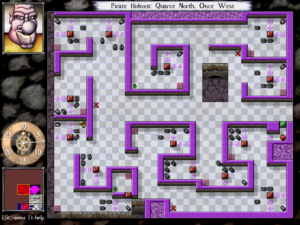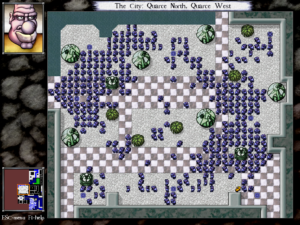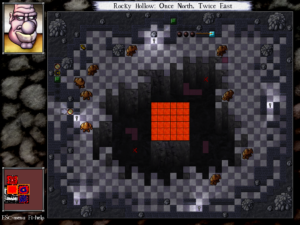 I don’t think I’ve adequately described the experience of solving a DROD room. There are essentially two modes of thought involved, which we may as well call “strategic” and “tactical”. The difference is that tactical thought involves using the “undo” feature repeatedly, whereas strategic thought involves “restart room”. Some rooms emphasize one, some emphasize the other. I recently encountered a room in the Pirate Hideout level that seems good for illustrating both modes and the interplay between them. The solution to this room is given away in some detail below.
I don’t think I’ve adequately described the experience of solving a DROD room. There are essentially two modes of thought involved, which we may as well call “strategic” and “tactical”. The difference is that tactical thought involves using the “undo” feature repeatedly, whereas strategic thought involves “restart room”. Some rooms emphasize one, some emphasize the other. I recently encountered a room in the Pirate Hideout level that seems good for illustrating both modes and the interplay between them. The solution to this room is given away in some detail below.
Basiclly, what we have here is a simple, wide-corridored maze sprinked with Roach Queens. The Roach Queens are held immobile in little chambers lined with one-way force arrows. The roaches spawned by the queens can get out of the chambers, but you can’t get in to kill the queens until you open a way in. All of the chambers have gates that are color-coded red, which means that they’ll only open after you’ve collapsed all of the trap doors in the room. The trap doors (which show as pink floor tiles in the screenshot above) are scattered throughout the maze. In addition, there’s a Brain in a small area that you can only exit through a green gate, which will open when all of the monsters are dead; this means that you have to kill the brain last. Understanding this gives you a series of strategic goals: go through every part of the maze stepping on trap doors, then go through it again killing roach queens, then kill the brain. This much, you could plausibly figure out just by looking at the level layout (although in practice there are always details that escape my attention until their importance is forced on me during play).
So far, so easy. The difficulty comes in when you actually have to navigate the maze, with roaches coming at you from all directions, guided by the brain. Remember, your sword only points in one direction at a time, and you can only swing it in a 1/8 arc per turn. So surviving involves tactics such as taking advantage of the walls for cover, going after small groups of roaches first in order to have fewer directions to watch, and maneuvering to kill one roach every turn whenever possible, lest they grow too numerous and choke the hallways.
In fact, it soon becomes clear that the queens in this room are generating roaches faster than you can kill them, and that to survive long, you need an extra edge. This is provided by speed potions. Introduced earlier in this level, speed potions are the level’s theme and the key to all of its rooms. They act pretty much like the speed potions in Nethack, allowing you to move at double speed until you leave the room. There are two in this room, but neither is easy to reach without getting killed. So, tactical concerns introduce a new strategic goal: get one of the speed potions before doing anything else. Once you’ve got the potion, you have to discover new tactics that take advantage of it. You still have to kill the roaches as efficiently as you can to avoid being overwhelmed, and a lot of the habits of defensive swordsmanship are no longer necessary. Given the right timing, you can defend a three-tile-wide hallway without retreating, or charge into a pair of roaches side by side, rather than spending a turn blocking one with your sword to separate them.
Now, it took me a while to notice this, but one of the two speed potions in the room, the one harder to reach, is not optional. You have to walk over it in order to reach one of the trap doors, and walking over a potion automatically applies it. I had naturally been going for the easier-to-reach potion first up to this point. What happens when you drink two speed potions? This was the first room to contain two, so I didn’t know. It turns out that they cancel out, reducing you to your original speed. This is disastrous. My first thought was that if I saved that trapdoor for last, I could immediately start killing queens, reducing the roach influx to something I could manage without the extra speed. This failed: you can kill at most one queen before getting killed. So I tried another approach: restarting from scratch and going for the hard-to-reach potion first. This took some tricky footwork, and I wasn’t really convinced that it was possible, but I did finally manage it, and was fairly confident that I had cracked the puzzle.
Once you start killing the queens, it’s all mopping up. The tactical concerns become gradually easier as roaches are produced in smaller numbers. After giving the screen a final look-over to make sure that I haven’t missed anything, I plunged my sword into the brain, and Beethro gave a hearty chuckle, a signal that the room was solved.
 Comments(2)
Comments(2)

